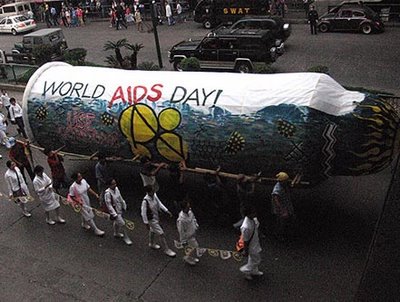 BAGUIO CITY, PHILIPPINES - Motorists trapped in the late afternoon rush hour were shocked on Thursday when artists, nursing students and gender rights activists wove through traffic along downtown Baguio carrying a 30-foot condom on their shoulders.
BAGUIO CITY, PHILIPPINES - Motorists trapped in the late afternoon rush hour were shocked on Thursday when artists, nursing students and gender rights activists wove through traffic along downtown Baguio carrying a 30-foot condom on their shoulders.The colorful condom was Baguio's contribution to the celebration of World AIDS Day on Friday, said Eden Divinagracia, executive director of the Philippine Non-Government Organization Council on Population Health and Welfare (PNGOC), which financed the creation of the giant condom.
Artists Roger Bibal, Kawayan de Guia, Allan Manalastas and Kigao Rosimo stretched wads of felt paper over a huge bamboo frame to simulate a condom.
On the condom's blue field, the artists painted yellow and white "sperm" cells, and drew a smiling orange face on the "condom's" tubular front end.
Some pedestrians froze on the streets when they saw the condom.
"I thought it was a very long bullet until I saw 'Safe Sex' painted [on the left section of the] condom. I could not stop giggling," a student said.
But government doctors promoting local reproductive health programs expressed reservations about the stunt with some calling it an "outrageous march."
Dr. Cecilia Brillantes, administrator of the city's social hygiene clinic, said AIDS awareness advocates had long shifted their advocacy from promoting condoms to securing finances for ailing AIDS patients.
"We admire the artists for constructing that large condom. But while we used to lobby for an ordinance that compels a 100 percent use of condoms in Baguio, we are now seeking a law that would create a trust fund to help AIDS victims," she said.
"We feel the trust funds have become a more important agenda than promoting condom use, although we are not stopping the advocacy for a condom [use] law."
The PNGOC condom march occurred on the same day a Baguio-based AIDS victim died in a local hospital, Brillantes said.
She said the victim's family could not afford a proper burial, much less a cremation, which is required by law. "I advised the victim's family to solicit funds from [local councilors], so we could give the victim a pauper's burial, while we lobby for the trust fund for future victims," she said.
Divinagracia said experts recorded 2,500 HIV-AIDS cases in the Philippines this year. National AIDS surveillance records showed 23 people tested positive in Baguio hospitals from 1992 to 2006, Brillantes said.
"Half of these victims were overseas contract workers. [Thursday's] death meant 12 of them have already died from the disease, so we want local governments to focus on policies that will help government doctors take care of these patients," she said.
She said the giant condom was not part of the city's official World's AIDS Day celebration on December 6.
Brillantes said Baguio's young generation understood the need for condoms but local politicians feared that condom promotion could be easily equated with encouraging sexual proximity.
"That is why we are cautious about outrageous gimmicks because we want to make sure everyone advocating AIDS awareness sends the right message," she said.
Divinagracia said the giant condom also championed the success of the Philippines' safe sex advocacy. She said the medical community acknowledged a "dramatic change in the past 10 years" since condom use was heavily promoted.
"Of course, we cannot [quantify] how much condoms [have been] used by checking the trashcans [all over the Philippines], but social hygiene clinics note a decrease in the cases of sexually transmitted diseases," she said.
She said an increase in condom use may explain the drop in recorded STD cases.
from INQ7 Network
No comments:
Post a Comment